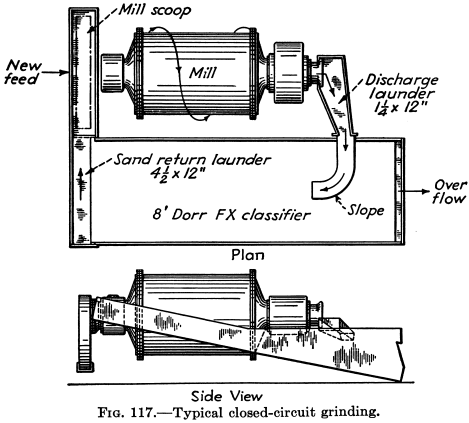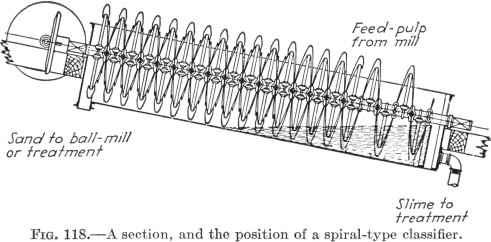A mill consists of a steel shell supported at each end by a hollow trunnion running in a bearing, lined with steel plates, and driven by belt and gears or by motor and gears. The mill is set at a slight slope and is fed with finely crushed ore and water through one trunnion. When ground fine enough by the load of balls, the pulp is discharged through the other trunnion and run where desired for further treatment. In some plants a ball-mill or rod-mill will reduce the ore to, say, 100 mesh and a tube-mill will finish the grinding to 200 mesh or finer. In other plants a ball- mill or a tube-mill will do all the grinding, but it must be fed with fine ore—say, 1/8 to ¼ inch—to do this properly. Grinding coarse ore in a ball-mill is done by steel balls of three sizes (5, 4, and 3 inches); fine ore is ground in a tube-mill by 2- and 1½-inch balls or by flint pebbles or by hard, rounded mine rock such as quartzite. These grinding media wear to small sizes, and new ones must be added regularly to make up the weight. When a mill is in closed circuit with a classifier, it will handle a circulating load of several times the amount of the original feed. The correct operation of a mill with proper load of balls and pulp or ore feed is determined by sound or by power meter. Normally, the sound is a rumble, whereas from a more or less empty mill there is a rattle. The speed of mills depends upon their diameter; a ball-mill of 3 feet revolves 35 times a minute, and one of 5 or 6 feet, 29 or 27 times. Tube-mills run at a revolution or two faster (see Fig. 117).
Some ores require much finer grinding than others to liberate the minerals, and this increases the milling cost.

Ball Mill Product Classifying
One passage of ore through a mill is seldom enough grinding to release gold and silver or other minerals from the gangue that encloses them; therefore, a classifier is worth installing to separate the sand from the slime and return the former for further grinding or for their separate treatment. Classification may be done in cones or in drag, rake, screen-wheel, spiral-within cylinder, and spiral-in-trough classifiers.
When a classifier is operated to separate the sand for further grinding, it is arranged in closed-circuit with a mill, which means that the coarse pulp is circulated and ground until it passes out of the classifier as slime. The classifier controls the size of the finished material. But when a classifier is arranged in open- circuit with a mill, the sand and slime are separated and flow, without further grinding, to their respective treatment. Unless such products are desired, open-circuit grinding is inefficient.
If unclassified pulp is sent to shaking tables or to flotation machines or other equipment, they do less effective work, which means losses; therefore, pulp should be separated into at least two grades—sand and slime—before being fed to any machine. Even collecting tanks in cyanide plants should receive sand pulp and slime pulp if two products are to be treated, although in some plants the whole pulp is run into one collector and the slime over-flows to its own tank, leaving the sand sometimes more or less slimy in the collector where it is now and then treated or discharged and filled into a treatment vat.
Rake and Drag Classifiers
The Dorr is the example of the rake, and the Esperanza of a drag. The former consists of a shallow rectangular tank in which are reciprocating rakes. There are several designs of the Dorr machine. The slime overflows at the lower end, and the sand at the upper end. In the drag type are scrapers affixed to an endless metal belt. The products of this type are sand and slime. These machines have large capacity or circulating loads and can be adapted to washing ores and sands of not too large a size (see Fig. 117 for a mill and classifier in closed circuit).
Spiral Classifiers
The Akins, Hardinge, and Western Machinery are examples of the spiral. The first two consist of a spiral rotating in an open steel trough or box set on a slope, the spiral working the sand to the upper end and the slime overflowing at the lower end. Spirals of 8 to 12 inches diameter are available for small plants. The 12-inch size is good for 12 tons a day. A 24-inch spiral will handle 35 tons. These machines have large capacity or circulating loads and may be used for washing ores and sands of not too large a size. The third make of classifier consists of a spiral within a sloping and rotating drum. The feed enters by pipe about mid-way up the drum and is separated into sand and slime like the other machines. The last classifier ranges in size

from 12 to 48 inches. Wash water is fed in at the top end. The flow of water and fines is countercurrent to the movement of the sand (see Fig. 118).
Classifier Ball Mill
There is also on the market a rib-cone screening ball-mill whose “classifier,” as it may be termed, is part of the mill. Capacities for prospectors are 2 to 4 and 4 to 8 tons through 35 mesh in 24 hours, requiring 1½ to 3 horsepower. The screen is as the discharge end of the mill. Washed oversize is returned to the inside by the action of the mill, and the fine material passes out to be treated.
